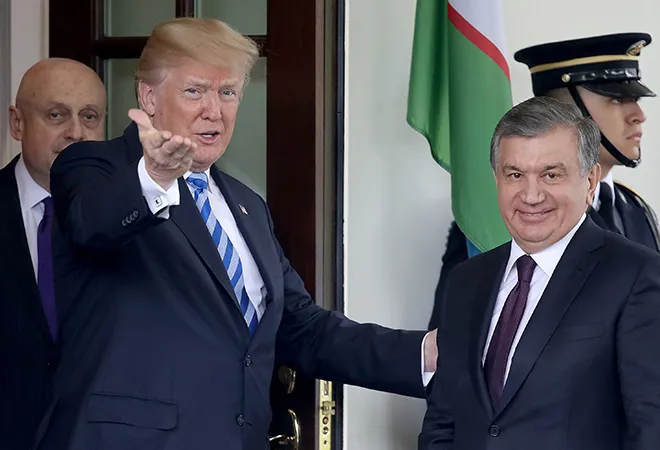
The United States recently chaired the C5+1 High Level Dialogue with the Central Asian states in a virtual format. Several issues including Afghanistan, regional connectivity, trade, and for the first time in the forum, the topic of the Aral basin, were discussed. The platform — created in Samarkand in 2015, which provides the US a platform to engage all the Central Asian states was one of the Obama administration’s key achievements which Donald Trump has continued.
Beyond Afghanistan
Central Asia has come a long way in US foreign policy from being perceived initially as the “Periphery of the Periphery” or on the “other side of the moon” of America’s foreign policy interests. With diverse agendas in varying degrees of importance, Central Asia never assumed the central position in American foreign policy interests until the 9/11 attack on its soil. The attack brought Central Asia right to the forefront of its interests. It did provide a real agenda for concrete cooperation with the Central Asian states. However, this shift in its policy also brought to the forefront the dilemma among US foreign policy makers regarding ways to deal with the Central Asian states, or rather the dilemma with regards to its objectives in Central Asia. It now had to deal with a region balancing its commitment to democracy, rule of law and human rights to gain strategic access to routes and pursue its “War on Terror” in Afghanistan. US administrations thereafter decided to constructively engage the Central Asian states, with Afghanistan however, dominating the agenda.
With diverse agendas in varying degrees of importance, Central Asia never assumed the central position in American foreign policy interests until the 9/11 attack on its soil.
The recently unveiled “United States Strategy for Central Asia 2019-2025: Advancing Sovereignty and Economic Prosperity” in February 2020 by the Trump administration also clearly reflects the heavy interlinking of US Central Asia policy with the situation in Afghanistan, two decades after the 9/11 attack. Two of the five policy objectives spelt out by the document (Expand and maintain support for stability in Afghanistan and Encourage connectivity between Central Asia and Afghanistan) inextricably link US Central Asia policy to its Afghanistan policy.
Afghanistan has dominated US approach towards Central Asia. It has also played an important factor in advancing its relations with certain Central Asian states. With the withdrawal of the US forces from Afghanistan dominating Trump’s political discourse, advancing relations with Afghanistan’s neighbouring states who would assist it in not only resolving the decades long conflict, but also share its perspectives with regards to the post-withdrawal power sharing agreements in Afghanistan, assumed importance gradually. The United States was essentially looking for a partner to assume the role of a regional leader to provide a platform for negotiations and rally neighbouring states for the same cause, and it found a perfect one in Uzbekistan.
Eyes on Uzbekistan
One of the most defining aspects of Trump’s Central Asia policy has been the strengthening of US relations with Uzbekistan. This was facilitated by the socio-political and economic reforms driven by Uzbekistan’s President Shavkat Mirziyoyev who assumed charge in 2016 following the demise of Islam Karimov. Mirziyoyev’s reforms, which were completely driven by an internal vector, allowed US to constructively engage with Uzbekistan even in a bipartisan manner. This confidence in the reforms was clearly reflected through the launch of the Uzbekistan caucus at the US House of Representatives, which conducted its first meeting in January 2019. Uzbekistan became the first Central Asian country to have a country-specific caucus in the US Congress. All these events have helped build trust which reflected in the negotiations over a five-year military-to-military cooperation between the two countries which was mentioned in the White House press release following Mirziyoyev’s first visit to the White House in 2018. Both the countries are still exploring the military aspect of the relations under the new framework.
Mirziyoyev’s reforms, which were completely driven by an internal vector, allowed US to constructively engage with Uzbekistan even in a bipartisan manner.
Another important aspect of the bilateral relation that further deepened their relation was their congruence of approaches over the resolution of the Afghanistan conflict. Mirziyoyev was quick to grasp Trump’s South Asia policy and the US withdrawal strategy from Afghanistan which involved negotiation with the Taliban and facilitating intra-Afghan negotiations. Uzbekistan hence assumed the regional leadership role to host both, the Taliban and the Afghan government separately to understand their concerns and provide a mediating platform. Receiving such active support from a regional country was a diplomatic success for Trump’s Central Asia and Afghan policy. Their approaches have converged to such an extent that US-Uzbekistan-Afghanistan trilateral meetings have assumed a recurring nature.
The Trump administration was also quick to understand the changing geopolitical scenario in Central Asia following Uzbekistan’s outreach to its neighbours which set the ball rolling for the regional integration process. Benefits accrued through the integration process are wider which left several states scrambling to exert their influence over the country, and through it to the wider region. Secretary of State Mike Pompeo hence visited Uzbekistan in the early 2020 to send a clear message that the US actively wants to be a part of this process, whether it is economic integration or political. Such a participation also broadens US engagement with the region which is bereft of any security engagement. The C5+1 forum is a perfect platform to further such an engagement with the region. If the United States hopes to rein in the Central Asian states in its agenda on Afghanistan, it must continue investing in the economic and social sectors.
Competing influences
However, a heavy focus on Afghanistan and reliance on Uzbekistan for support on the same means United States will have to make certain compromises with regards to its other objectives — like weaning Central Asian states away from the orbit of Russia’s influence. This was clearly visible when the Uzbekistan Senate recently voted with a huge margin on 11 May in favour of participating in the Russia led Eurasian Economic Union (EaEU) as an observer state. This was despite verbal warning from the US Secretary of Commerce Wilbur Ross when he was addressing the American–Uzbekistan Chamber of Commerce Annual Business Forum in October 2019. Ross clearly warned Uzbekistan against participating in EaEU when he said, “pursuing membership right now in the Eurasian Economic Union could complicate and extend the WTO accession process beyond the timeline set by Uzbekistan’s leaders.”
Uzbekistan also finds itself among other Central Asian states excluding Kyrgyzstan, in the Cold War-era Jackson-Vanik Amendment, a 1974 amendment to the US Commerce Act which restricts trade with countries that impede emigration and violate human rights. While addressing the media following US Secretary of State Mike Pompeo’s visit to Uzbekistan in February this year, US Ambassador to Uzbekistan Daniel Rosenblum linked Uzbekistan’s removal from the Jackson-Vanik amendment as conditional to its accession to the World Trade Organisation (WTO). Uzbekistan’s entry into the WTO would facilitate its removal from the US self-imposed trade restrictions which currently are applicable to not only Uzbekistan but Tajikistan, Turkmenistan and Kazakhstan as well.
Uzbekistan also finds itself among other Central Asian states excluding Kyrgyzstan, in the Cold War-era Jackson-Vanik Amendment, a 1974 amendment to the US Commerce Act which restricts trade with countries that impede emigration and violate human rights.
While Uzbekistan has received a temporary waiver in the restrictions under the amendment, it is subject to annual review by the Congress. At a recent virtual meeting in June 2020 attended by the members of the Uzbekistan caucus in the US Congress and the First Deputy Chairman of Uzbekistan Senate, the topic of Uzbekistan’s removal from the amendment was discussed. However, it remains to be seen how long and for what purpose would the US continue the decades old relic, despite several calls from not only Uzbekistan but other Central Asia states as well to lift these restrictions. Simultaneously, meetings of the working group on Uzbekistan’s accession to the WTO are scheduled to resume in July. Considering Uzbekistan’s vote to participate in the EaEU, it seems undeterred by US warnings.
With regards to China and the issue of Xinjiang, the Trump administration at the highest levels has been extremely vocal about cautioning Central Asian states with regards to their relations with China. While the US did not receive much support from the Central Asian states in publicly criticising China for its Xinjiang policy, it however understands the growing anti-China sentiment, evident through protests, among the citizens in Kyrgyzstan and Kazakhstan. When urging Central Asian states to not deport Uyghur nationals and provide them asylum, Pompeo has been directly addressing that section of the Kazakh and Kyrgyz society while simultaneously cautioning Uzbekistan of the pitfalls of deeper cooperation with China.
It hence raises an important question with regards to US response towards Central Asia’s relations with Russia and China. Does the US in general, and the Trump administration in particular, have a differing approach towards Central Asia developing their relations with Russia and China? And if so, does that mean US does not consider Russia as a threat to its interests in the region anymore, as compared to China? Several developments in the coming years would bring out more clarity to this aspect of US Central Asia policy.
When urging Central Asian states to not deport Uyghur nationals and provide them asylum, Pompeo has been directly addressing that section of the Kazakh and Kyrgyz society while simultaneously cautioning Uzbekistan of the pitfalls of deeper cooperation with China.
US policy towards Central Asia has thus evolved through these years which also reflected changes in its internal domestic environment. Various concerns were addressed in varying degrees at different times dominating the agenda towards dealing with the region. From being largely aloof from the developments in the region, it has eventually gained a considerable influence and a footprint. The Trump administration further consolidated the relationship by garnering regional support for its Afghan policy. The negotiation process between the Taliban and the Afghan government as well as the developments in intra-Afghan negotiations were extremely important since defined US relations with the region too.
However, the US will have to look at the region not only through the lens of Afghanistan but also from a different perspective which would aim to address alternate influences in the region.
The views expressed above belong to the author(s). ORF research and analyses now available on Telegram! Click here to access our curated content — blogs, longforms and interviews.




 PREV
PREV


